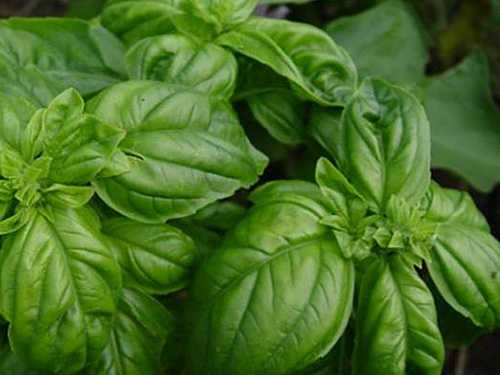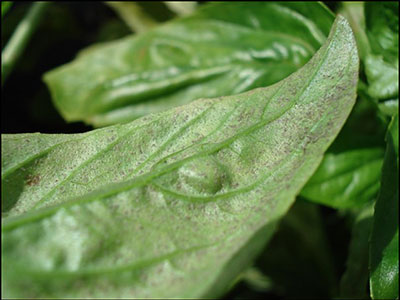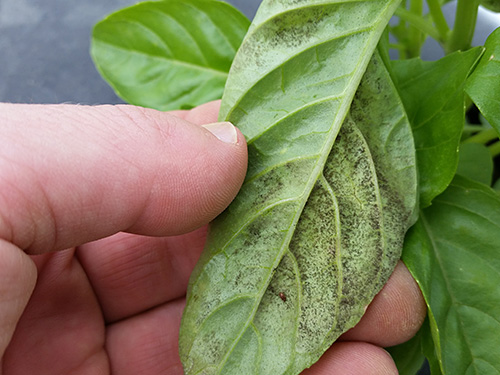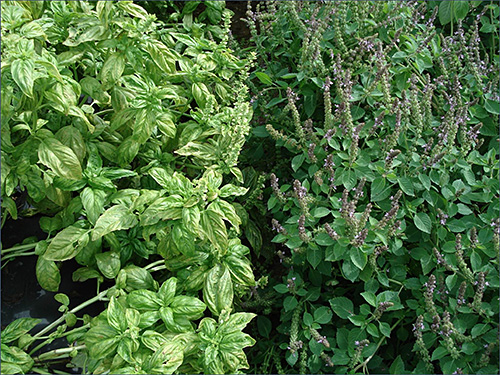
Fact Sheet FS1279
Ultra-Niche Crops are defined as exceptionally high-value crops that can provide a significant source of income to the farmer while using minimal land area.
Basil is an excellent fresh-market herb to grow on small acreages for direct sales to restaurants, farmer's markets, and specialty grocery stores. This tender annual is appealing to growers because of the constant demand from consumers. There are many factors to consider when determining whether to add basil to the list of crops to grow. This fact sheet will walk growers through some critical considerations about the production and marketing of fresh-market basil so they can make informed decisions.
Marketing
Who will buy the crop?
Fresh-market basil can be sold at roadside markets, community supported agriculture operations (CSAs), farmer's markets, grocery stores, or restaurants. Consider the customer you are selling to when deciding on which varieties or basil types to grow, as this will be a major factor in your success. While local chefs may want a lemon, lime, or cinnamon basil, most consumers are going to want the traditional, sweet basil varieties (i.e., Italian) that they recognize.
How suitable is this crop for agritourism?
This herb is an ideal crop for diverse operations and can be sold in a variety of ways. Customers may simply enjoy picking their own basils, which can be sold by the pound or bundle. Potted or container-grown basil plants of varying types can also be an attractive item for customers as edible ornamentals to be used in the landscape or in containers.
How well does this crop withstand shipping?
Basil is susceptible to cold and damaged by rough handling. Injury to the leaves during packing, handling, or shipping can significantly reduce the shelf life and value of the crop. When possible, sell your product directly to consumers or restaurants as soon after harvesting as feasible.
What packaging should be used?
Packaging for fresh-market basil will vary depending on the production system and how it is being sold. Regardless of the type of container, moisture and cool (55–60°) temperatures should be maintained during display. Basil should be removed from the sun as soon as possible after harvest and placed in a cool location. Moisture loss can be reduced by packing the basil into bags or clamshells quickly. Any bags or containers must not damage the product. If displaying bunched basil stems at a market location, standing the bundles upright in a cooler with water at the bottom to keep the leaves looking fresh. Nursery flats are an option to help keep the basil upright in the cooler while the stems are in the water.
Farmer's Tool Box
Essential Equipment/Supplies
- Seeder (suitable for small seeds)
- Sharp, sterilized knives for harvest
- Fertilizer
- Plastic mulch
- Irrigation tape
- Hand hoes (weed control between beds)
- Harvest containers
Crop Requirements
Soil
pH range 6.0–7.0, well-drained. Crop rotation with plants other than basil or from the mint family (Lamiaceae) for 2–3 years is important to reduce the risk of Fusarium wilt and other soil-borne diseases. Basil prefers sandy to sandy loam soils.
Water
Basil requires daily watering during extended hot periods. Many basil growers rely on overhead watering. If possible, drip irrigation is recommended to reduce the risk of foliar diseases such as basil downy mildew. Avoid standing water or watering at night. Keeping the foliage dry could help reduce disease pressure.
Light
Basil needs full sun and temperatures ideally around 86° or higher to thrive.1
What is the number of frost-free days required to grow this crop?
Basil requires 85–90 frost-free days before the first cold snap in the fall. At 40° F, basil will show cold injury on leaves.
Is frost damage a common threat?
Yes, if temperatures fall below 40° F basil will show cold injury and turn black. Sowing and/or transplanting into the field later in the spring protects against early frosts. Use of low or high plastic tunnels are also used to ensure an early harvest for fresh basil. The tunnels can be lifted after frost-free dates are past.
Timeline for basil in New Jersey
Basil can be planted spring through fall but it is recommended to grow in the spring because of downy mildew, which arrives later in the season in the northeastern United States (US). Days to harvest can range from 60 to 85 days in the field depending on when the crop was seeded or transplanted, daily temperature, and watering schedule, but traditionally falls between late spring and early fall. Days to harvest are less if grown in a greenhouse or high tunnel.
Growing the Crop
How are basil plants started?
There is a large selection of seed companies that sell many different varieties and types of basil. Most seed are produced outside of the United States, therefore selecting reputable seed sources is important. Seed may be infested with basil downy mildew (BDM) or Fusarium wilt (see disease section below). There are no effective seed treatments for BDM although some seed companies in Europe are starting to treat seed with proprietary technology. Before purchasing seed ask if seed has been treated for basil downy mildew.
How is this soil prepared and how is crop typically planted?
For a direct-seeded basil crop, sow seeds in a well-prepared seedbed. A small, manual seeder will allow for even seeding. Cover seeds with a thin layer of soil mixed with vermiculite or peat and be sure to keep the soil surface moist to prevent soil crusting. Seed at 3 to 6 lbs. per acre and thin after emergence based on plant density desired.
Space rows 2–3 feet apart (this may vary depending on cultivation equipment) and plants 6–12 inches within the row. Double-rows may also be planted on 3-foot-wide beds to increase yields and help to shade out potential weeds. The use of mulch is highly recommended to conserve moisture, reduce weed pressure, and keep the basil leaves free of splashing soil. The use of raised beds is important to provide soils at warmer temperatures and to increase air flow and drainage.
What is the optimal number of plants per acre?
While large wholesale growers produce as much fresh weight per acre as possible (e.g., 50,000 lb/A), smaller growers should seed based on desired needs and preferred harvest time (i.e., seeding in blocks based on date of seeding).
What is the general care and maintenance of the crop during the growing season?
Weed control is critically important for a successful crop. Diseases such as basil downy mildew or Fusarium wilt may pose a significant threat. Scouting of the crop must be done regularly to identify pests and control insect and disease in a timely manner. Fertilization requirements for basil is determined by soil type, preceding applications of fertilizer, and earlier crops planted in the same space. In general, a fertilizer that provides nitrogen, phosphorus, and potassium is recommended. Sweet basil and Thai basil respond well to high levels of nitrogen—in conventional or organic form. Fertilizer can be spread over a field and tilled in or applied between the rows of the growing crop.
How is harvesting performed?
Basil can be harvested by hand by pinching off branches or leaves or by using sharp scissors or knives. If selling bunches of stems they can be bundled in the field or a designated packing area.
When is the basil harvested?
Basil is harvested based on the desired size of the leaves. Individual leaves may be harvested or by pinching off the branches with one or more sets of leaves. To ensure a longer harvest season, plants should not be over-harvested. At least four sets of true leaves should be left to allow for continued growth of the plant. Flowers should be pinched so that they are not permitted to form, they reduce the flavor quality of the leaves. Basil can get bitter later in the season during and after flowering.
Popular Varieties for Fresh Market
- Genovese – Classic.
- Napoletano – Standard lettuce-leaved.
- Romanesco – Large leaf with strong scent.
- Dolly – Heavy production of large leaves. More cold tolerant.
- Italian large leaf or DeGenova - Classic large-leaf type, slightly sweeter than Genovese.
Distinctive Flavors and Aromas for Restaurants and Niche Markets
- Cinnamon – Distinctive cinnamon taste and aroma.
- Citrus – Intense lemon or lime fragrance. Try 'Sweet Dani' Lemon Basil or 'Mrs. Burns Lime'.
- Clove – Spicy scented leaves.
- Thai – Anise-like scent. Try 'Siam King' or 'Queen'.
- Purple Ruffles - Slight clove scent.
- Dark Opal - Brilliant purple. Try 'Osmin'.
- Holy Basil - Sweet and spicy.
Common Basil Diseases
Fusarium wilt
Fusarium oxysporum f. sp. basilica, or Fusarium wilt, is an economically important disease in basil production. The pathogen may be introduced into the field via infested seed, contaminated equipment, or on infected transplants. Once present in a field or high tunnel the fungus can overwinter and survive for a long period of time (up to 10 years without a host present).
Symptoms/Signs
Infected plants may be stunted and will begin to wilt because the plant is unable to uptake water. Vascular tissue may show discoloration (i.e., browning). Depending on infection level and weather conditions, plants will begin to wilt and drop leaves, nearby plants may also begin to wilt and die as the pathogen moves in the soil by water movement.
Disease Cycle
The pathogen can persist (i.e., overwinter) in the soil for many years without a basil host therefore proper crop rotation is necessary. Infested seed can introduce the pathogen into your operation.
Management Strategies
- Plant resistant cultivars. There are sweet basil cultivars such as 'Nufar' and a new sweet basil Rutgers (cv. Newton) from the Rutgers University Basil Breeding Program which has resistance to Fusarium wilt.
- Avoid planting basil crops in same area or field each year. Rotate with other species of herbs or other vegetable crops that are not in the mint family. Have at least a 2 to 3 year rotation between all basil crops.
- Avoid planting basil in fields with a known history of Fusarium wilt.
- Avoid excess irrigation.
- Remove and appropriately discard infected plants from the field.
Basil Downy Mildew
Basil downy mildew, caused by Peronospora belbahrii, is a relatively new and devastating disease of basil throughout the U.S. and the world. The pathogen was first discovered in the U.S. in Florida in 2007. Basil downy mildew on infested seed is the most likely reason for its introduction into the U.S. As well as with seed, infected transplants may also be a source of introduction into a field, greenhouse, or high tunnel. The pathogen is unable to survive or overwinter without a living host. Therefore, it will not survive or overwinter in fields or gardens. The pathogen can also be spread naturally and at great distances with natural weather patterns and is typically introduced into the mid-Atlantic region from southern locations each growing season.2
Symptoms/Signs

Figure 1. Basil downy mildew sporulating on the underside of an infected basil leaf
Infected plants of any size may begin to develop chlorotic (i.e., yellow) leaves. Under warm and humid conditions, masses of purplish-brown spores of the fungus will develop on the undersides of leaves. Spores are easily spread by wind, rain, or overhead irrigation to healthy plants. An entire field can become infected in a matter of days leading to 100% crop loss. Symptoms can be initially confused with nitrogen deficiency as the upper leaves will get a chlorotic appearance. The underside of leaves will have dark spores if downy mildew is present (Fig. 1).
Disease Cycle
The pathogen will not survive without a living host (i.e., basil). Once frost kills the plant in the fall the pathogen will not survive. Basil downy mildew will not overwinter in the soil.
Basil downy mildew can only be introduced into a field, greenhouse, or high tunnel via infected seed, infected transplants, or from outside sources through naturally-occurring weather events. The severity of infection is due to weather conditions. Disease development is favored by prolonged warm, humid wet weather.
Management Strategies
- Purchase seed from a reputable source. Some commercial seed companies are now doing seed treatments for downy mildew.
- Inspect any transplants for downy mildew symptoms before purchasing.
- Seed or transplant basil for production in early spring or summer before natural weather patterns bring it into the region.
- Avoid planting basil in late summer or fall, especially if basil downy mildew is already causing significant losses in region.
- Seed or transplant in an open and sunny location that promotes leaf drying and good air circulation.
- Space rows and plants further apart to promote leaf drying and good air circulation.
Considerations for Organic Production
Basil can be grown organically but crop rotation, purchasing disease tolerant varieties and purchasing disease free seed are critical. It is recommended that organic growers produce their crop in spring and early summer before downy mildew arrives in the region. It should be noted that hot-water seed treatment is not advised for basil seeds as they produce a gel-like substance when submerged in hot water. There are several Organic Materials Review Institute (OMRI)-approved fungicides available on the market with varying efficacy in controlling fungal diseases. Remember that basil sells because of how it looks; fungicide applications (in both organic and conventional production systems) can impact its visual marketability.
Critical Considerations
Determine who your desired customer is prior to planting basil. How do they want to purchase the basil? By the pound, as a living plant, or by stem? What type of basil are they most likely to purchase? Consider flavors, colors, and leaf shapes too.
- Keep in mind the labor-intensive nature of this crop. Harvesting is done by hand.
- Basil downy mildew is more common on sweet basil types. Red, Thai, lemon, lime, and other spice types have been less susceptible to downy mildew.
References
1 Mijani, S., Nasrabadi, S. E., Zarghani, H., & Abadi, M. G. (2013). Seed germination and early growth responses of Hyssop, Sweet Basil and Oregano to Temperature Levels. Notulae Scientia Biologicae, 5(4), 462.
2 McGrath, M.T., A. Wyenandt and J Simon. Downy Mildew Wars: A monitoring program can help growers determine if the basil downy mildew pathogen is present in their area. American Vegetable Grower. February 2010:10.
Additional Information
- Mid-Atlantic Commercial Vegetable Production Guide, Specialty Vegetables njaes.rutgers.edu/pubs/commercial-veg-rec/specialty-vegetables.pdf
- Crop Profile for Basil in New Jersey. ipmcenters.org/cropprofiles/docs/NJbasil.pdf
For more information on this and other Ultra-Niche Crops please visit our website njaes.rutgers.edu/ultra-niche-crops.
All photos by Andy Wyenandt.
March 2018
Copyright © 2024 Rutgers, The State University of New Jersey. All rights reserved.
For more information: njaes.rutgers.edu.
Cooperating Agencies: Rutgers, The State University of New Jersey, U.S. Department of Agriculture, and Boards of County Commissioners. Rutgers Cooperative Extension, a unit of the Rutgers New Jersey Agricultural Experiment Station, is an equal opportunity program provider and employer.




 Project sponsored by the USDA-NIFA Beginner Farmer and Rancher Development Program.
Project sponsored by the USDA-NIFA Beginner Farmer and Rancher Development Program.